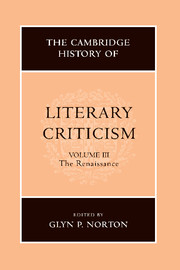Book contents
- Frontmatter
- Introduction
- READING AND INTERPRETATION: AN EMERGING DISCOURSE OF POETICS
- POETICS
- THEORIES OF PROSE FICTION
- 29 Theories of prose fiction in England: 1558–1700
- 30 Theories of prose fiction in sixteenth-century France
- 31 Seventeenth-century theories of the novel in France: writing and reading the truth
- 32 Theories of prose fiction and poetics in Italy: novella and romanzo (1525–1596)
- CONTEXTS OF CRITICISM: METROPOLITAN CULTURE AND SOCIO-LITERARY ENVIRONMENTS
- VOICES OF DISSENT
- STRUCTURES OF THOUGHT
- NEOCLASSICAL ISSUES: BEAUTY, JUDGEMENT, PERSUASION, POLEMICS
- A SURVEY OF NATIONAL DEVELOPMENTS
- Bibliography
- Index
- References
32 - Theories of prose fiction and poetics in Italy: novella and romanzo (1525–1596)
from THEORIES OF PROSE FICTION
Published online by Cambridge University Press: 28 March 2008
- Frontmatter
- Introduction
- READING AND INTERPRETATION: AN EMERGING DISCOURSE OF POETICS
- POETICS
- THEORIES OF PROSE FICTION
- 29 Theories of prose fiction in England: 1558–1700
- 30 Theories of prose fiction in sixteenth-century France
- 31 Seventeenth-century theories of the novel in France: writing and reading the truth
- 32 Theories of prose fiction and poetics in Italy: novella and romanzo (1525–1596)
- CONTEXTS OF CRITICISM: METROPOLITAN CULTURE AND SOCIO-LITERARY ENVIRONMENTS
- VOICES OF DISSENT
- STRUCTURES OF THOUGHT
- NEOCLASSICAL ISSUES: BEAUTY, JUDGEMENT, PERSUASION, POLEMICS
- A SURVEY OF NATIONAL DEVELOPMENTS
- Bibliography
- Index
- References
Summary
Narrative fiction in Italy was already strongly rooted in the heritage of Boccaccio and his successors by the time Pietro Bembo's Prose della volgar lingua appeared in 1525, having earned a conspicuous place within the prevailing literary tastes and social codes of the day. In Book II of Castiglione's The courtier, Federico Fregoso describes the practice of ‘long and continuous discourse’ [‘ragionar lungo e continuato’] by certain men who ‘so gracefully and entertainingly narrate [‘con tanto bona grazia e così piacevolmente narrano’] …, that with gestures and words they put it before our eyes and almost bring us to touch it with our hand’. Fregoso's homage to the gift of narration is striking not only for its social ratification of a broad literary trend, but for the way it frames this gift within qualities of presentation that give a subtle nod to the concept of enargeia and the rhetoric of presence discussed by François Rigolot elsewhere in the present volume. Strongly reminiscent of Leon Battista Alberti's remarks on istoria in the Della pittura (c. 1435), Fregoso's statement sanctions the practice of narration as a social event vested with its own aesthetic and rhetorical justification. The reach of this activity extends even into such paraliterary forms as letters and treatises (political, theoretical/descriptive, moral/philosophical) where fictional narratives are frequently embedded as diversions in a larger ‘scientific’ project (for example, the letters of Pietro Aretino and Giambattista Marino, Aretino's Ragionamenti and Carte parlanti, and Alessandro Piccolomini's La Raffaella).
- Type
- Chapter
- Information
- The Cambridge History of Literary Criticism , pp. 322 - 336Publisher: Cambridge University PressPrint publication year: 1999
References
- 1
- Cited by



